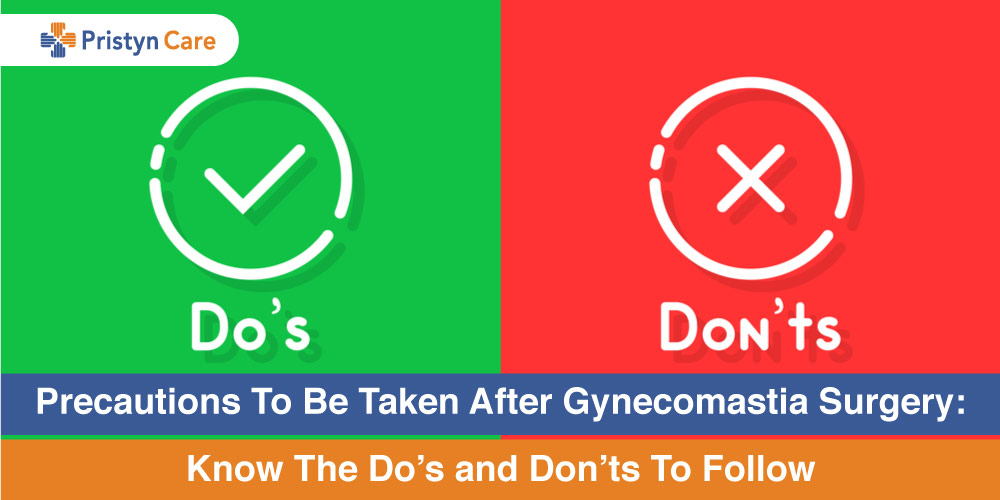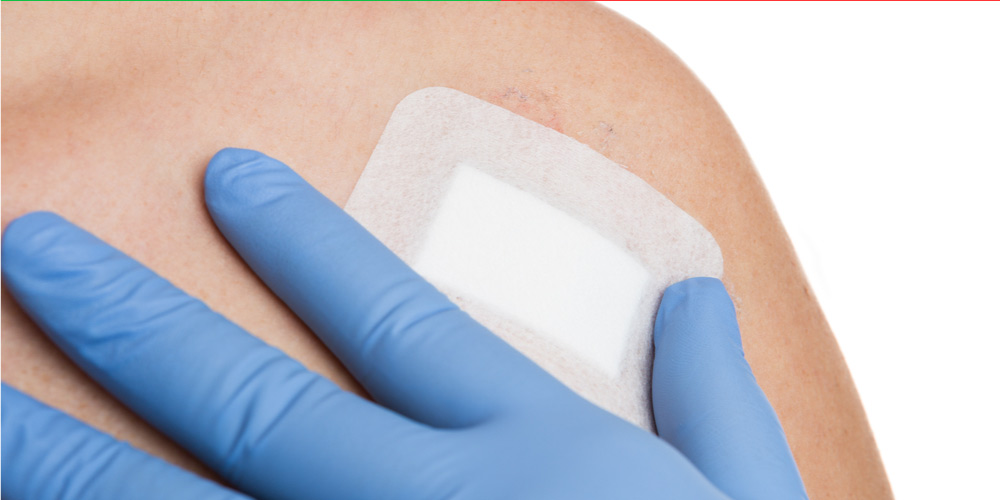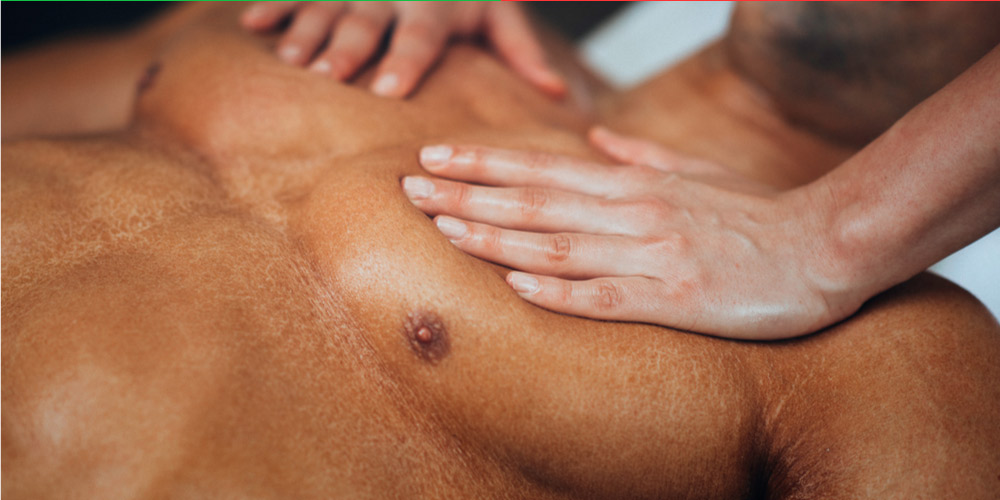
The recovery period after any surgery is very crucial. Similarly, it is important to follow the doctor’s instructions about wound care, dietary tips after gynecomastia surgery. This will ensure that the patient recovers fast without any complications. Moreover, it also ensures that the results of the surgery are long-lasting and desirable. At Pristyn Care, our doctors provide patients with a set of instructions after the surgery. Here’s what you need to know.
Table of Contents
What To Expect After Gynecomastia Surgery?
Scars
During a gland excision surgery, the doctors make several incisions around the breast that can later be visible as scars. A highly experienced surgeon should ideally make the incisions around the places that are not easily visible. In severe cases, to form scar tissue around the wound that can appear bumpy. In such instances, laser-based scar treatment can be beneficial.
Bruising and Swelling
After 2-3 days of the surgery, there will be some bruising and swelling around the breasts. These may be sore to touch too. The severity of the pain may differ from individual to individual based on the patient’s tolerance as well as the extent of the surgery.
There can be bruising too. It can be mild to severe. It can be confined to the wound area or expand to the chest. Or, the bruising can be of varied shades in purple, black, blue, bright red. However, there’s nothing to sleep about. These get treated with time.
Loss of Sensation
You may experience a loss of sensation around the wound area for a month or two. In most cases, the loss of sensation is only temporary. However, if the sensation doesn’t return even after a month or two, get in touch with the doctor.
Shrinking of the Areola
This is a common phenomenon that occurs after gynecomastia surgery. The reason being that as glandular tissues are removed, the diameter decreases ten to fifty percent from the actual size.
Precautions to Take after having Gynecomastia Surgery
After having gynecomastia surgery, you will have to pay more attention to your overall health especially the wound and your diet. So, we are listing some precautions that you need to take for quick recovery.
Wound Care after Gynecomastia Surgery

During the discharge, the doctor will guide you on how to take care of the wound. Here’s what to do-
- Before touching the wound, make sure that you wash your hands properly. Once the wound is cleaned, wash hands thoroughly again.
- There might be some drainage. Clean it properly with the gauge provided.
- Keep the wound area as dry as possible until the stitches completely dissolve.
- Avoid wearing clothes that can irritate the wound area.
- Let the surgical glue dry up on its own.
- Dress the wound as directed by the surgeon regularly.
The wound won’t need extensive care, but it is necessary that you don’t let it get infected at any cost.
Diet after Gynecomastia Surgery
As there is blood loss during the surgery, diet plays an integral part in the recovery process. Once the patient reaches home, he is being put on a liquid diet. This majorly includes yogurt, pudding, milk (soy, almonds or cow), broths, soups, juices, etc. Gradually, over the period, there is transition to solid diets.
It is important that there is no extra pressure on the wound. Hence, minimize the chances of constipation. To avoid the risk of constipation, eat meals that are rich in fiber. Some of the foods to fasten the recovery process include-
- Fruits, vegetables, beans and legumes, grains, nuts and seeds, oats, almonds, pistachios, etc.
- For a while, avoid consuming meat products because these are not easily digestible by the body. Also, cabbage, corn, broccoli, capsicum can cause abdominal pain. Avoid these as much as possible.
During the recovery, make sure you eat foods that keep the testosterone levels in check. Some of the foods you should include in the daily diet are-
- Encourages testosterone production
- Reduces body fat and chest fat
Without a proper diet, you won’t be able to get all the essential nutrients needed for faster recovery. So, make sure that you eat healthy meals throughout the day.
Wear a Compression Garment
Initially, in the first 24 hours of the surgery, wear a compression garment. This will help to reduce the swelling and minimize the pain. You may need to adjust the garment every 2 hours. Ensure that the garment is not too tight. Such that you can put one finger between the garment and the body. As there will be drainage from the wound, put some special pads to absorb these. For the first week, you need to wear this throughout the day, grad, reduce it to 18 hours. Purchase compression garments that are washable.
Read more: Food guide for gynecomastia patients
Deep Tissue Massage

After 3 weeks of the surgery, massage the chest several times for 20 minutes or more. This can help in achieving the desired results of gynecomastia as the skin remains soft and malleable. Massage the area for at least 8 weeks daily till the scar tissue softens and the skin gets smooth and even. One can use the tips of the finger or a roller to massage the area. After proper consultation with the doctor, you can also use a lubricant for massage.
Taking a Shower
In the initial 24 hours of the surgery, the chest will be fully bandaged. Hence, make sure that you don’t get it wet or else, there can be chances of infection. Hence, avoid taking a shower meanwhile. Once the bandages are removed after the surgery, you can take a cool shower. Preferably, take a sponge bath. Make sure that water runs over the breasts. After this, again restrict taking a bath for at least two weeks
Relief from Pain
Generally, doctors prescribe ibuprofen acetaminophen to treat mild pain or inflammation. However, there can be some minor side effects such as stomach upset, bleeding in the digestive tract, and difficulty to retain urine.
For severe pain, doctors even recommend narcotics. However, the side effects of taking narcotics are severe. Some common side effects of narcotics are sleep deprivation, low blood pressure/heart rate, and breathing rate. There can be incidences of skin rash, itching, constipation, nausea, and difficulty while urinating.
If the pain is mild, you can also get relief by avoiding medicines. Here’s what you can try-
- Distract yourself by engaging and shifting your focus in other activities such as listening to music, playing games such as sudoku.
- The cushion is the best buddy for every gynecomastia patient who has undergone surgery. While coughing or any movement, extra pressure is put on the affected area. In such cases, use a pillow to cover the area.
- Guided imagery is another way. This helps to control the emotions and fight your pain. Simply close your eyes and try to imagine the beauty around you so that you feel calmer.
Do’s & Don’ts after Gynecomastia Surgery
| Do’s | Don’ts |
| Wear a compression garment | Go directly under the sunlight for at least six weeks or until the bruising subsides |
| Take brisk walks from the second day of recovery | Perform any strenuous activities |
| Engage yourself in moderate activities | Practice any kind of exercises such as aerobics, running or swimming for at least 2-3 weeks |
| Listen to your body | Drive for at least 24 hours of the surgery |
| Drink lots of fluids during the recovery period. | Drink alcohol for at least 72 hours of the surgery |
How Long Does It Take To Recover After Gynecomastia Surgery?
There are a couple of factors that affect the recovery duration of a patient after the surgery. The factors include the patient’s own physical abilities, pain tolerance, the technique of the surgery used as well as the extent of the tissue removed. Usually, the patient is able to fully recover within 4-6 weeks of the surgery.
When To Visit The Doctor?
If the recovery is not proper, it can lead to some complications. These complications require immediate medical help. Look out for the following symptoms-
- Excessive swelling around the breasts
- Extreme pain around the wound
- Fever that doesn’t seem to come down
- Chills
- Nausea or vomiting
Read more:







